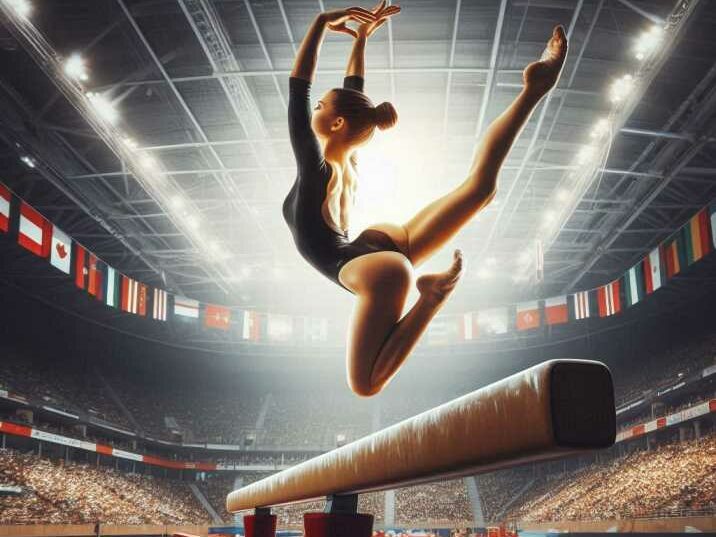When you think of gymnastics, do you picture athletes gracefully flipping through the air, balancing on a beam, or twisting on the rings? Gymnastics combines power, flexibility, and elegance like no other activity, but it often leaves people wondering if it is truly a sport.
The question Is Gymnastics a Sport? In this post, we’ll explore whether gymnastics qualifies as a sport. We’ll look at its history, the skills required, and its recognition in the sports community. Whether you’re a parent considering enrolling your child in gymnastics or just curious, this detailed guide will provide all the necessary information.

What Defines a Sport?
Table of Contents
The Elements of a Sport
Before we tackle whether gymnastics is a sport, we need to understand what defines a sport. Generally, a sport requires physical exertion, skill, and competition. It often involves organised rules and objectives. Other factors include the need for training, the presence of a governing body, and the opportunity for competition at various levels, from local to international.
Physical Exertion
One of the core elements of any sport is physical exertion. It’s hard to argue that gymnastics doesn’t fit this criterion. Gymnasts undergo rigorous physical training to build strength, flexibility, and endurance. From performing flips and turns to hold static positions, gymnastics demands a high level of physical effort.
Skill and Technique
Skill is another essential element of sports. Gymnastics requires various skills, from basic movements to complex routines that take years to perfect. The sport involves precision, balance, coordination, and timing. Training often starts at a young age, and mastering the various techniques can take a lifetime.
The History of Gymnastics
Ancient Origins
Gymnastics has a rich history dating back to ancient Greece, where it was primarily used for military training. The Greeks believed that developing physical strength and flexibility was essential for warriors. These early forms of gymnastics included running, jumping, and wrestling.
Modern Gymnastics
Modern gymnastics began in the 19th century, thanks largely to Friedrich Ludwig Jahn, also known as the “father of gymnastics.” He developed many of the apparatuses used in the sport today, such as parallel bars and high bars.
Gymnastics in the Olympics
Gymnastics has been a part of the Olympic Games since its modern inception in 1896. Its inclusion in one of the world’s most prestigious sporting events underscores its recognition as a legitimate sport. Over the years, the sport has evolved, adding new disciplines like rhythmic gymnastics and trampoline.
The Skills Required in Gymnastics
Strength and Power
Gymnasts need exceptional strength and power to perform their routines. Whether holding a still position on the rings or launching into a series of flips, the sport requires intense upper and lower body strength. Weight training, resistance exercises, and bodyweight exercises are all integral parts of a gymnast’s training regimen.
Flexibility and Agility
Flexibility is another crucial aspect of gymnastics. Athletes must perform splits, twists, and bends without injuring themselves. This flexibility is often achieved through rigorous stretching routines and specialised flexibility training.
Balance and Coordination
Even the slightest misstep in gymnastics can lead to a fall or a deduction in points. Therefore, balance and coordination are essential skills. Gymnasts train on various apparatuses, such as the balance beam, to hone these abilities. Coordination is also vital for synchronising movements in routines, especially in disciplines like rhythmic gymnastics.
Mental Toughness and Discipline
Beyond the physical skills, gymnastics requires a significant amount of mental toughness and discipline. The sport demands intense focus and concentration, as even a minor lapse can result in serious injury or a failed routine. Gymnasts must also manage fear and nerves, particularly when performing high-risk elements. This mental resilience is built through consistent practice, mental conditioning, and sometimes through the guidance of sports psychologists. Additionally, the discipline needed to endure long hours of training, often in a structured and demanding environment, is a testament to the athlete’s dedication to mastering their craft.
Recognition in the Sports Community
Governing Bodies
The presence of governing bodies is a strong indicator that gymnastics is a sport. The International Gymnastics Federation (FIG) is the main governing body for the sport. It oversees competitions, sets rules, and ensures the sport is practised safely and fairly.
Competitive Levels
Gymnastics offers a range of competitive levels, from local meets to international championships like the World Championships and the Olympics. Athletes can compete individually or as part of a team, and there are various age categories, from youth to senior levels.
Awards and Accolades
Gymnasts are recognised and rewarded for their achievements, much like athletes in other sports. Medals, trophies, and titles are awarded at competitions, and standout gymnasts often become household names. Icons like Simone Biles and Nadia Comăneci have achieved global recognition for their extraordinary talents.
Cultural Impact
Gymnastics has left a lasting impact on popular culture, inspiring countless individuals with its blend of athleticism and artistry. Iconic gymnasts like Nadia Comăneci, Simone Biles, and Kohei Uchimura have become household names, symbolizing excellence and dedication. Their contributions to the sport have elevated gymnastics’ status and inspired new generations of athletes.
The multifaceted nature of gymnastics, requiring physical strength, technical skill, and mental fortitude, underscores its legitimacy as a sport. Its storied history, global recognition, and cultural impact further solidify its standing in the world of athletics.
The Psychological Aspect of Gymnastics is a Sport
Mental Strength
Gymnastics is not just physically demanding; it also requires mental fortitude. Athletes must focus intensely, often under pressure, to execute their routines flawlessly. Cognitive training, including visualisation techniques and stress management strategies, is crucial to a gymnast’s preparation.
Overcoming Fear
Gymnastics involves performing high-risk manoeuvres, which can be intimidating. Overcoming fear is a significant psychological challenge that gymnasts face. Coaches work closely with athletes to build their confidence and help them tackle these fears head-on.
Discipline and Commitment
The level of discipline and commitment required in gymnastics is immense. Athletes often train for several hours daily, balancing their time between school, family, and social activities. This dedication is a testament to the sport’s demands and the athletes’ passion.
The Role of Coaches and Support Staff
Coaching Techniques
Coaches play a vital role in the development of gymnasts. They provide technical guidance, design training programs, and offer emotional support. Effective coaching techniques include breaking down complex skills into manageable steps, providing constructive feedback, and fostering a positive training environment.
Support Staff
Beyond coaches, gymnasts rely on a team of support staff, including physiotherapists, nutritionists, and sports psychologists. These professionals help athletes maintain their physical health, optimise their performance, and manage the psychological demands of the sport.
Parental Involvement
For younger gymnasts, parental support is crucial. Parents often invest significant time and resources into their child’s gymnastics career, providing transportation, emotional support, and encouragement. Their involvement can significantly impact the athlete’s development and success.
The Future of Gymnastics
Technological Advancements
Technological advancements are likely to shape the future of gymnastics. Innovations such as motion capture technology, virtual reality training, and advanced sports analytics can enhance training methods and improve performance assessment.
Growing Popularity
Gymnastics continues to grow in popularity, with increasing participation rates and media coverage. The sport’s inclusion in mainstream fitness programs and its portrayal in popular culture contribute to its rising popularity.
Inclusivity and Diversity
The gymnastics community is making strides toward greater inclusivity and diversity. Efforts are being made to ensure that the sport is accessible to individuals of all backgrounds, and initiatives are in place to promote gender equality and representation.
Table of Information Is Gymnastics a Sport?
| Topic | Details |
|---|---|
| Brief History | Originated in ancient Greece; evolved through the 19th and 20th centuries into a modern competitive sport |
| Key Components | Strength, flexibility, balance, coordination, and mental fortitude |
| Famous Gymnasts | Simone Biles, Nadia Comăneci |
| Training | Rigorous, often several hours daily |
| Competition | Involves routines judged on difficulty, execution, and artistic performance |
| Mental Strength | Focus, visualization techniques, stress management |
| Risk and Fear | High-risk maneuvers require overcoming significant fear |
| Support Staff | Coaches, physiotherapists, nutritionists, sports psychologists |
| Technological Advancements | Motion capture, virtual reality training, sports analytics |
| Inclusivity and Diversity | Initiatives for gender equality, representation, and accessibility |
| Role of Parents | Emotional support, transportation, encouragement |
| Benefits | Physical fitness, mental discipline, confidence, competition opportunities |
Conclusion
Is Gymnastics a Sport? Gymnastics is undeniably a sport. It meets all the criteria, from physical exertion and skill to competition and organisation. The sport’s rich history, rigorous training, and recognition at the highest levels of competition further solidify its status. Whether you’re an aspiring gymnast or a fan, there’s no denying the incredible athleticism and dedication that gymnastics demands.
Ready to explore the world of gymnastics? Sign up for a trial class at your local gymnastics club and experience the thrill of this captivating sport. And if you’re already a gymnast, keep pushing your limits and reaching for the stars.
FAQs
Is gymnastics a sport?
Yes, gymnastics is a sport. It involves physical exertion, skill, and competition and is governed by official bodies like the International Gymnastics Federation (FIG).
What skills are required for gymnastics?
Gymnastics requires strength, flexibility, balance, coordination, and mental fortitude. Athletes undergo rigorous training to develop these skills.
How is gymnastics judged in competitions?
Gymnastics competitions are judged based on the difficulty and execution of routines. Points are awarded for technical skills, artistic performance, and overall presentation.
Can anyone learn gymnastics?
Yes, gymnastics can be learned at any age. Many gyms offer beginner classes for all age groups, from toddlers to adults.
What are the benefits of doing gymnastics?
Gymnastics offers numerous benefits, including improved physical fitness, mental discipline, confidence, and the opportunity to compete at various levels.


